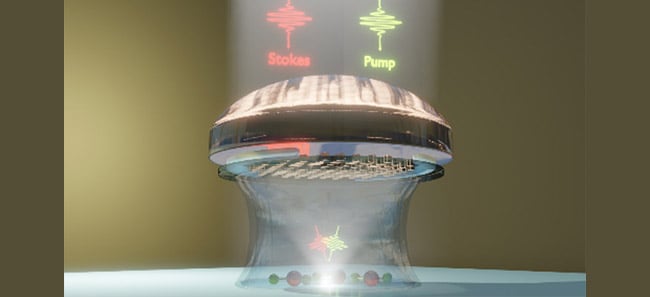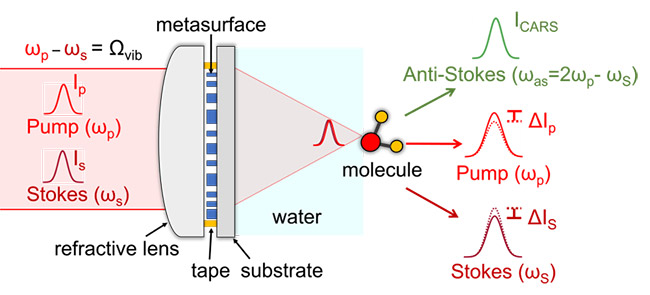
Hybrid Metalens Supports Miniaturized Optics for Endoscopy
Researchers at Boston University and Harvard University, with colleagues from the Misr University for Science and Technology in Egypt and the University of Waterloo in Canada, developed an achromatic, hybrid metalens that is designed to focus two different wavelengths in the near-infrared region. The metalens can support coherent Raman scattering (CRS) imaging in miniaturized optical devices and endoscopes. Its small size could lead to new opportunities for endoscopy development.

Researchers at Boston and Harvard Universities, with colleagues from the Misr University for Science and Technology in Egypt and the University of Waterloo in Canada, developed an achromatic, hybrid metalens that is designed to focus pump and Stokes wavelengths in the near-infrared region. The new metalens could open the path for miniaturized endoscopy development. Courtesy of Kerolos M. A. Yousef, Harvard University.
CRS microscopy, based on coherent anti-Stokes Raman scattering (CARS) or stimulated Raman scattering (SRS), is a label-free, high-spatial-resolution, chemical-specific imaging technology. Yet, current benchtop CRS microscopes are bulky and limited in their capacity to image lesions and internal organs in the human body. To overcome this limitation and enable more precise medical diagnoses, scientists and medical personnel require miniaturized, hand-held endoscopes that can be directly applied to the body.
In 2018, a group led by Ji-Xin Cheng at Boston University developed and introduced a hand-held SRS microscope using a miniatured objective lens. The Cheng-led group’s current technology aims to further reduce the diameter of the lens to 1 to 2 mm, to move toward endoscopy applications.
The hybrid metalens consists of a low-cost, 2-mm-diameter, plano-convex refractive lens, attached to a 1.5-mm-diameter metasurface consisting of 1-μm-high silicon nanopillars. The researchers assembled the miniature refractive lens and the metasurface under a laboratory-built microscope, converting an off-the-shelf plano-convex lens into a water-immersion, nearly diffraction-limited, achromatic lens.
One of the biggest challenges for the team was to make the lens achromatic before focusing the pump and Stokes beams through the lens. “This is essential for coherent Raman imaging,” Cheng said.
The researchers used ray-tracing software to calculate the phases and group delays of all incident rays. They adjusted the phase profile of the metasurface and the focal length of the hybrid metalens so that all incident rays would arrive at the focus with nearly the same phase and group delay. This step helped to correct monochromatic and chromatic aberrations in the refractive lens.
After verifying the hybrid metalens’ focal spot size and depth of focus, the researchers demonstrated its potential for miniature endoscopic CRS imaging through spectroscopic and volumetric CRS imaging of bead and tissue samples. They showed that the hybrid metalens could achromatically focus wavelengths of 800 nm and 1040 nm with near diffraction-limited performance, making it suitable for use with SRS and CARS imaging.
They used the hybrid metalens to image 1-μm polystyrene (PS) beads at 2955 cm-1. Results showed a 1.3X and 3.8X improvement in lateral and axial resolution, respectively, compared to results from using the refractive lens only.

This diagram depicts the setup of the hybrid, achromatic water-immersion metalens. The metasurface comprising amorphous silicon nanopillars is designed to ensure that all incident rays arrive at the focus with the same phase and group delay, leading to corrections of monochromatic and chromatic aberrations of the refractive lens, respectively. The achromatic focusing enables coherent Raman scattering of the molecules of interest. Courtesy of Peng Lin, Boston University.
Using a spectral focusing approach, the researchers showed that the hybrid metalens could enable spectroscopic forward SRS and backward (epi-) CARS imaging for mapping and differentiating between polymethylmethacrylate (PMMA) and PS beads.
The researchers further demonstrated how the new metalens could be used in volumetric CRS imaging with samples of PMMA beads, mouse ear, and ovarian cancer tissue. The findings from these experiments could lead to new ways to develop miniaturized, metalens-based CRS endoscopic imaging systems.
High-performance, miniature objective lenses that allow high-quality focusing and support both pump and Stokes laser wavelengths are essential for developing hand-held CRS imaging systems. Since CARS and SRS use two synchronized pulsed laser beams of different wavelengths (pump and Stokes) to match a Raman transition, the lenses used for these modalities need to tightly focus the laser beams to the same spot to obtain optimal signals and 3D sectioning resolution.
Because of their compact footprint and versatile optical properties, metasurface-based optical components have found broad applications in miniaturized optical systems, depth sensing, pulse shaping, and polarization control. The hybrid metalens, specifically designed for pump and Stokes wavelengths at the near-infrared region, could support and strengthen the trend toward miniaturization of optical devices for CRS endoscopy development and the clinical use of CRS imaging.
“My group has developed small-footprint, optical components based on metasurfaces that are flat and designed to correct the aberrations of conventional refractive optics without resorting to the complex objectives typical of microscopes,” said professor Federico Capasso at Harvard John A. Paulson School of Engineering and Applied Physics (SEAS). “The realization of a coherent Raman scattering imaging probe with a miniature achromatic metalens is a demonstration of the power of meta-optics in miniaturizing optical systems, and holds promise for major advances in label-free in vivo optical diagnosis with CRS endoscopes.”
The researchers will continue to increase the focusing efficiency of the hybrid lens. They will also investigate the possibility of designing a finite conjugate metalens that focuses light from a fiber to a sample with a single element. Such a design could further reduce the footprint of the hybrid metalens, compared to systems that use only refractive elements. Also, it could be used in an emerging approach to miniature CRS imaging probes that is based on fiber scanning.
The research was published in APL Photonics (www.doi.org/10.1063/5.0059874).
Published: September 2021